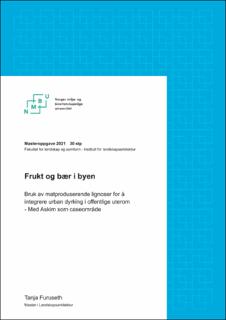| dc.contributor.advisor | Ødegård, Ingrid Merete | |
| dc.contributor.advisor | Remberg, Siv Fagertun | |
| dc.contributor.advisor | Evensen, Katinka Horgen | |
| dc.contributor.author | Furuseth, Tanja | |
| dc.coverage.spatial | Norway, Østfold, Indre Østfold, Askim | en_US |
| dc.date.accessioned | 2021-10-19T08:34:35Z | |
| dc.date.available | 2021-10-19T08:34:35Z | |
| dc.date.issued | 2021 | |
| dc.identifier.uri | https://hdl.handle.net/11250/2823806 | |
| dc.description.abstract | Urban dyrking har hatt en økende popularitet de siste årene, og finnes i mange forskjellige former. Interessen for å delta i dyrkningsprosjekter er stor, og ventelisten for å leie en parsellhage er lang. Samtidig er det begrenset med grøntareal i byene, og de urbane dyrkningsområdene er ofte private, eller halvprivate. Denne oppgaven tar for seg hvordan urban dyrking kan benyttes i offentlige byrom, slik at matnyttige planter blir en varig del av byens grønnstruktur i større grad. Samtidig åpner dette opp for at landskapsarkitekter kan bidra mer når urbane dyrkingsprosjekter planlegges.
Oppgaven tar for seg hvordan fruktbærende planter som trær, busker og klatreplanter kan brukes for å etablere urbane dyrkningsprosjekter for allmennheten. Fordeler, utfordringer og muligheter utforskes, og det presenteres oversikter over aktuelle arter og utformingsprinsipper for disse. Til slutt anvendes funn fra oppgaven for å velge et prosjektområde i Askim og prosjektere dette. Prosjekteringsarbeidet gjøres for å illustrere et eksempel for hvordan frukt- og bærarter kan benyttes i et offentlig uterom, og ulike hensyn som bør tas.
Urban dyrking, i form av frukt- og bærarter i offentlig uterom, kan bringe med seg mange fordeler og skape flerfunksjonelle byrom som har stor verdi i de kompakte byene. Disse plantene er riktignok kostbare elementer som krever mer planlegging og oppfølging enn de mer tradisjonelle parkplantene. De viktigste faktorene for suksess er å bruke et egnet areal, egnede frukt- og bærarter, planlegge godt, ha nok
ressurser og bruke et velfungerende system for ivaretagelse. Slik kan urban dyrking bli tydeligere i bybildet og tilgjengelig for alle. | en_US |
| dc.description.abstract | Urban cultivation has gained increasing popularity in recent years and exists in numerous variations. The interest to participate in cultivation projects is enormous, and the waiting list for renting allotment gardens is long. Simultaneously, there is limited green space in the cities, and the urban cultivation areas are often private or semi-private. This thesis will examine how urban cultivation can be used in public urban spaces, as a means to make edible plants become a more permanent part of the city’s green structure at large scale. At the same time, this opens up for landscape architects to contribute to a greater extent when urban cultivation projects are planned.
The thesis analyses how fruit-bearing plants such as trees, bushes and climbing plants can be used to establish urban cultivation projects for the public. Advantages, challenges and opportunities are explored, and overviews of relevant species and design principles for these are presented accordingly. Finally, findings from the thesis are used to identify a project area in Askim and design it. The design work illustrate how fruit- and berry species can be used in a public outdoor space, and the various considerations that should be taken
into account.
Urban cultivation, in the form of fruit- and berry species in public outdoor spaces, can bring many benefits and create multifunctional urban spaces that have great value in the compact cities. These plants are admittedly expensive elements that require more planning and follow-up than the more traditional park plants. The most important factors for success is to use a suitable area, suitable fruit and berry species, plan well, have enough resources and use a well-functioning system for maintenance. In this way, urban cultivation can become more evident in the cityscape and accessible to everyone. | en_US |
| dc.language.iso | nob | en_US |
| dc.publisher | Norwegian University of Life Sciences, Ås | en_US |
| dc.rights | Attribution-NonCommercial-NoDerivatives 4.0 Internasjonal | * |
| dc.rights.uri | http://creativecommons.org/licenses/by-nc-nd/4.0/deed.no | * |
| dc.title | Frukt og bær i byen : bruk av matproduserende lignoser for å integrere urban dyrking i offentlige uterom : med Askim som caseområde | en_US |
| dc.title.alternative | Fruits and berries in the urban city : the use of food-producing woody plants to integrate urban cultivation in public outdoor spaces : with Askim as the case area | en_US |
| dc.type | Master thesis | en_US |
| dc.description.localcode | M-LA | en_US |

